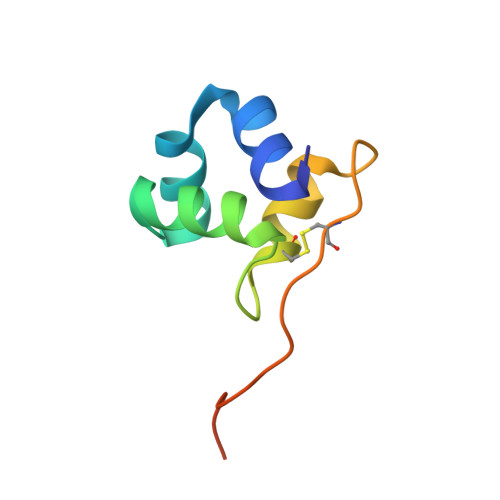Multistep mutational transformation of a protein fold through structural intermediates.
Kumirov, V.K., Dykstra, E.M., Hall, B.M., Anderson, W.J., Szyszka, T.N., Cordes, M.H.J.(2018) Protein Sci 27: 1767-1779
- PubMed: 30051937
- DOI: https://doi.org/10.1002/pro.3488
- Primary Citation of Related Structures:
5W8Y, 5W8Z - PubMed Abstract:
New protein folds may evolve from existing folds through metamorphic evolution involving a dramatic switch in structure. To mimic pathways by which amino acid sequence changes could induce a change in fold, we designed two folded hybrids of Xfaso 1 and Pfl 6, a pair of homologous Cro protein sequences with ~40% identity but different folds (all-α vs. α + β, respectively). Each hybrid, XPH1 or XPH2, is 85% identical in sequence to its parent, Xfaso 1 or Pfl 6, respectively; 55% identical to its noncognate parent; and ~70% identical to the other hybrid. XPH1 and XPH2 also feature a designed hybrid chameleon sequence corresponding to the C-terminal region, which switched from α-helical to β-sheet structure during Cro evolution. We report solution nuclear magnetic resonance (NMR) structures of XPH1 and XPH2 at 0.3 Å and 0.5 Å backbone root mean square deviation (RMSD), respectively. XPH1 retains a global fold generally similar to Xfaso 1, and XPH2 retains a fold similar to Pfl 6, as measured by TM-align scores (~0.7), DALI Z-scores (7-9), and backbone RMSD (2-3 Å RMSD for the most ordered regions). However, these scores also indicate significant deviations in structure. Most notably, XPH1 and XPH2 have different, and intermediate, secondary structure content relative to Xfaso 1 and Pfl 6. The multistep progression in sequence, from Xfaso 1 to XPH1 to XPH2 to Pfl 6, thus involves both abrupt and gradual changes in folding pattern. The plasticity of some protein folds may allow for "polymetamorphic" evolution through intermediate structures.
Organizational Affiliation:
Department of Chemistry and Biochemistry, University of Arizona, Tucson, Arizona, 85721-0088.














